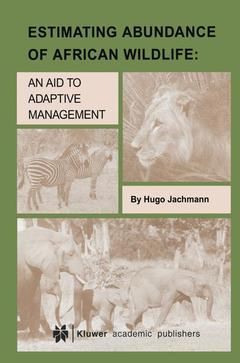Description
Estimating Abundance of African Wildlife, Softcover reprint of the original 1st ed. 2001
An Aid to Adaptive Management
Author: Jachmann Hugo
Language: English
Subjects for Estimating Abundance of African Wildlife:
Keywords
forest; mammals; production; economic geology; ecotoxicology
Approximative price 158.24 €
In Print (Delivery period: 15 days).
Add to cart
Estimating Abundance of African Wildlife
Publication date: 10-2012
285 p. · 15.5x23.5 cm · Paperback
Publication date: 10-2012
285 p. · 15.5x23.5 cm · Paperback
Approximative price 158.24 €
Subject to availability at the publisher.
Add to cart
Estimating abundance of african wildlife
Publication date: 03-2001
285 p. · 15.5x23.5 cm · Paperback
Publication date: 03-2001
285 p. · 15.5x23.5 cm · Paperback
Description
/li>Contents
/li>
Estimating abundance of wildlife is an essential component of a wildlife research program, and a prerequisite for sound management. With the exception of a few highly mathematical volumes, there are no books on the subject for use by students and field workers. Also, the various techniques for counting animals found in scientific journals are often not accessible to African managers. The unavailability of the diverse literature necessitated the production of a textbook or field manual that covers the ground. The book compiles the most relevant techniques for counting African mammals, illustrated with many examples from the field. It provides guidelines for selecting the appropriate methodology for a range of conditions commonly found in the field, in terms of different animal species, habitat types, and management objectives.
I: Introduction.- 1: Introduction to Estimating Wildlife Abundance.- 1.1 A Brief Overview of Techniques.- 1.2 Selection of a Technique.- 2: Interpretation of Population Estimates.- 2.1 Population Estimate.- 2.2 Variance, Standard Error and Confidence Limits.- 2.3 Bias and Accuracy.- 2.4 Stratification.- 2.5 Random Sampling versus Systematic Sampling.- 2.6 Sample Count Theory.- 2.7 Categorisation of Data.- II: Direct Counts: Part IIa: Ground Count Techniques.- 3: Ground Count Techniques; an Introduction.- 3.1 Total Ground Counts.- 3.1.1 Total Ground Counts of Hippos and Crocodiles.- 3.1.2 Total Ground Counts Using Individual Recognition.- 3.2 Sample Ground Counts.- 4: Line Transect Counts.- 4.1 Theoretical Background.- 4.1.1 Conceptual Background.- 4.1.2 Different Shapes of the Detection Function.- 4.2 Software to Analyse Line Transect Data.- 4.3 Survey Design.- 4.3.1 Stratification of the Survey Area.- 4.4 Field Procedures.- 4.5 Precision and Accuracy of Line Transect Results.- 4.6 Data Analysis with Program Distance.- 4.6.1 Analysing the Lupande Warthog Data with Program Distance.- 4.6.2 Analysing the Lupande Elephant Data with Program Distance.- 4.7 The Mean Perpendicular Distance Method.- 4.7.1 Data Analysis using the Mean Perpendicular Distance Method.- 4.7.2 Analysing the Lupande Warthog Data with the MPD Method.- 4.7.3 Analysing the Lupande Elephant Data with the MPD Method.- 4.8 Vehicle Counts.- 4.8.1 Road Counts.- 4.9 Comparative Costs of Sample Counts on the Ground.- II: Direct Counts: Part IIb: Aerial Count Techniques.- 5: Aerial Total Counts.- 5.1 Sources of Bias in Aerial Total Counts.- 5.2 Census Design.- 5.3 Aerial Total Counts of Hippos and Crocodiles.- 5.4 The Double Count Method.- 5.5 Field Example of Observer Bias Experiments.- 5.6 Field Example of Visibility Bias and Sighting Probability Bias Experiments.- 6: Aerial Sample Counts.- 6.1 Choice of Sample Unit.- 6.1.1 Blocks.- 6.1.2 Transects.- 6.2 Survey Design.- 6.3 Positioning the Streamers.- 6.4 Analysis.- 6.4.1 Jolly’s Method 1 for Equal Sized Sample Units.- 6.4.2 Jolly’s Method 2 for Unequal Sized Sample Units.- 6.5 Precision in Relation to Density and Sampling Intensity.- 6.5.1 Density and Precision.- 6.5.2 Sample Size and Precision.- 6.6 Field Example of an Aerial Survey.- 6.6.1 Analysis of a Stratified Design.- 6.7 Comparative Costs of Aerial Counts.- III: Indirect Counts: Part IIIa: Special and Index Techniques.- 7: Special Techniques.- 7.1 The Mark/Recapture Method.- 7.2 Field Example.- 7.3 Estimating Abundance through Radio-Tracking.- 7.4 Field Example.- 7.5 Estimating Abundance using DNA Analysis.- 8: Index Counts.- 8.1 Field Example of a Patrol Index Count.- 8.2 Monitoring of Sex and Age Ratios, and Juvenile Mortality.- III: Indirect Counts: Part IIIb: Indicator Techniques.- 9: Dropping Counts.- 9.1 Theoretical Concept.- 9.2 Dropping Counts in Woodland Savanna.- 9.2.1 Defecation Rate.- 9.2.2 Decay Rate.- 9.2.3 Analysis.- 9.3 Dropping Counts in Forests.- 9.3.1 Defecation Rate.- 9.3.2 Decay Rate and Analysis.- 9.4 Dropping Counts on Roads.- 9.4.1 Validity of the Method.- 9.4.2 Sample Design and Analysis.- 9.4.3 Field Examples.- 9.5 Sources of Error.- 9.6 Faecal Counts of Other Species.- 10: Footprint Measurements.- 10.1 Concept, Sample Design and Analysis.- 10.2 Field Example.- 10.3 Costs of Indicator Counts.- IV: Analysing Distribution Data and Population Trends.- 11: Analysing Animal Distribution, Movements and Population Trends.- 11.1 Analysis of Animal Distribution and Movements.- 11.2 Field Example.- 11.3 Analysing Population Trends.- 11.4 Field Example.- V: Synthesis.- 12: Deciding on a Technique.- 12.1 The Reasons for Counting.- 12.2 The Animal Species.- 12.3 The Habitat Type.- 12.4 The Budget.- 12.5 Making a Decision.- References.- Appendices.- Appendix I: A Brief Manual to Program ‘Aerial’.- Appendix II: Program ‘Aerial’ in Quickbasic 4.5.
© 2024 LAVOISIER S.A.S.
These books may interest you

The Biology of African Savannahs 75.15 €

The Biology of African Savannahs 158.58 €


